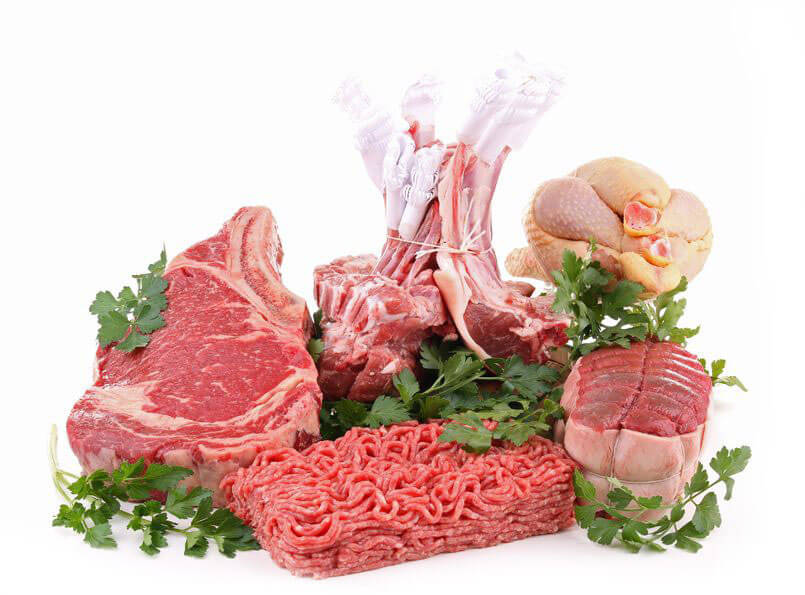
About Mid-Town Favorite Beef
History
Mid-Town Beef Co. Inc., was purchased in 1974 by the Bouvier Family and became a father and son operation. Father Donald and Son Paul operated the growing business together for the next four years at which time brother Steven joined the team. Together they successfully managed and grew the “custom cut wholesale meat business” creating a fully USDA operation servicing the Greater Twin City area. Eventually the business was expanded to include a broadline of products to better service their customers. Over the years the Bouviers created lifelong relationships with their valued customers. The philosophy of this company was to service with integrity and value. Throughout the years many members of the family filled various positions within the company sticking with the family values they believed in.
Today
Indulge in the epitome of culinary craftsmanship with our exclusive line of premium custom cuts of meat. In 2015, we expanded our operations by acquiring Mid-Town Beef Co. of Fitchburg, MA, giving birth to Mid-Town Favorite Beef, our esteemed brand that embodies excellence in meat products.
Located in our state-of-the-art facility in Massachusetts, we take great pride in offering an extensive selection of meticulously crafted cuts of beef, pork, lamb, and veal. Each day, our team of skilled butchers expertly cuts, processes, and vacuum seals these exceptional meats to ensure maximum freshness and flavor.
We understand that superior quality is paramount when it comes to meat products. That’s why we meticulously source our meat from trusted suppliers, adhering to the highest standards of animal welfare and sustainable practices. This commitment to excellence is reflected in every cut we offer, providing you with an unparalleled dining experience.
Whether you require prime steaks for an upscale steakhouse, succulent pork chops for a cozy bistro, tender lamb for a gourmet establishment, or delicate veal for a refined culinary creation, our premium custom cuts are tailored to meet your specific needs and elevate your dishes to new heights.
Experience the art of culinary perfection with Mid-Town Favorite Beef. Let our premium custom cuts of meat be the centerpiece of your exceptional creations, captivating your guests and setting your establishment apart. Trust in the quality, reliability, and expertise that our brand represents, and savor the difference that only the finest cuts of meat can deliver.
Custom Cuts
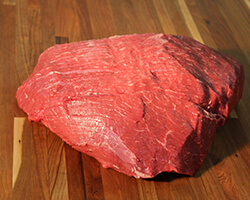
A round steak is a beef steak from the “round”, the rear leg of the cow. The round is divided into cuts including the eye (of) round, bottom round, and top round, with or without the “round” bone (femur), and may include the knuckle (sirloin tip), depending on how the round is separated from the loin.
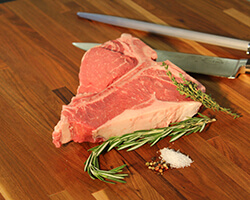
Porterhouse steaks are cut from the rear end of the short loin and thus include more tenderloin steak, along with (on the other side of the bone) a large strip steak.
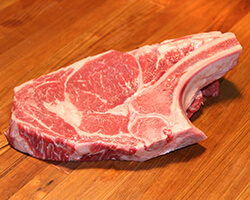
A rib-eye bone in steak that is fine-grained and juicy. Rich, beefy flavor and generous marbling throughout. One of the most tender beef cuts.
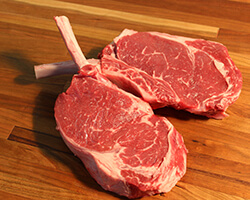
A rib-eye steak is a beef steak sliced from the rib primal of a beef animal, with rib bone attached.
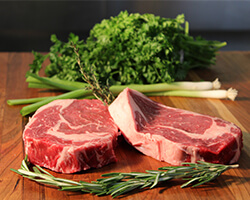
Delmonico steak refers to a method of preparation from one of several cuts of beef (typically the Rib Cut) prepared Delmonico style.
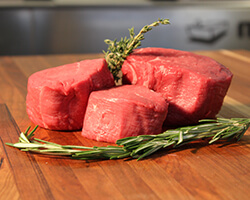
The most tender beef cut. Lean yet succulent, elegant and convenient. Buttery texture, subtle flavor and compact shape.
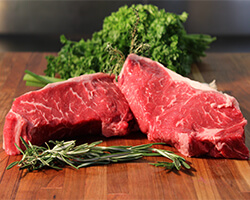
Family-sized steak that offers lean, well-flavored and moderately tender beef at an affordable every day price. Convenient and a great value with no bones and little fat. Versatile, juicy and delicious.
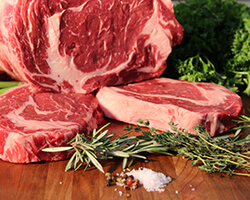
A beef roast from the rib section between the short loin and the chuck. Accompanied with a Delmonico Steak.
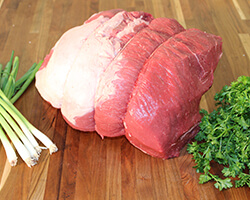
Economical, moderately tender roast. The whole top round weighs approximately 15-17 pounds.
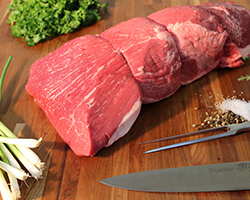
Economical, moderately tender roast. The whole top round weighs approximately 15-17 pounds.
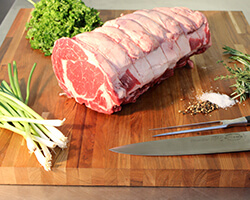
Tender juicy flavor. Prime rib cut.
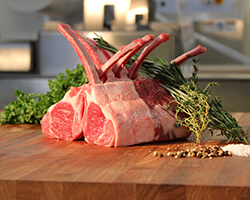
Rack of lamb is often “Frenched”, that is, the rib bones are exposed by cutting off the fat and meat covering them. Typically, three inches of bone beyond the main muscle are left on the rack, with the top two inches exposed.
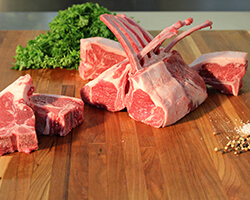
A rack of lamb is a cut of lamb cut perpendicularly to the spine, and including 16 ribs or chops. Can be sold ‘single’ (sawn longitudinally and including the 8 ribs on one side only), but may also be sold as a “double rack of lamb”, with the ribs on both sides.
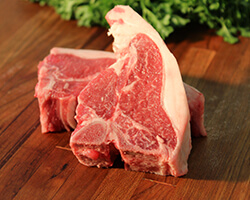
Freshly chopped lamb cuts.
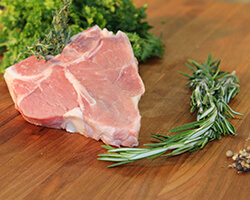
Veal Porterhouse Chop is lean and tender. Cut to a perfect portion that is sure to satisfy any appetite!
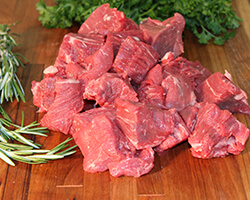
Tender meat of the muscle running through the sirloin and terminating before the ribs.
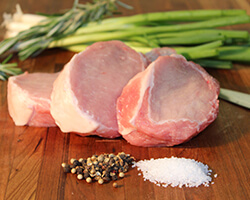
Pork chops cut perpendicularly to the spine of the pig and usually containing a rib or part of a vertebra, served as an individual portion.
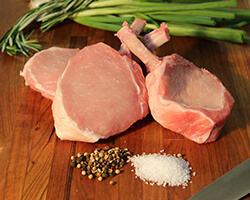
Pork chop cuts away from the end of a rib or chop, so that part of the bone is exposed.
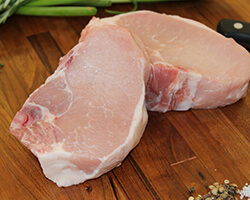
Cut from the back portion of a pork loin that is left when the centre loin is removed by a straight cut down in front of the hipbone. A small portion of tenderloin may be included on the bottom.
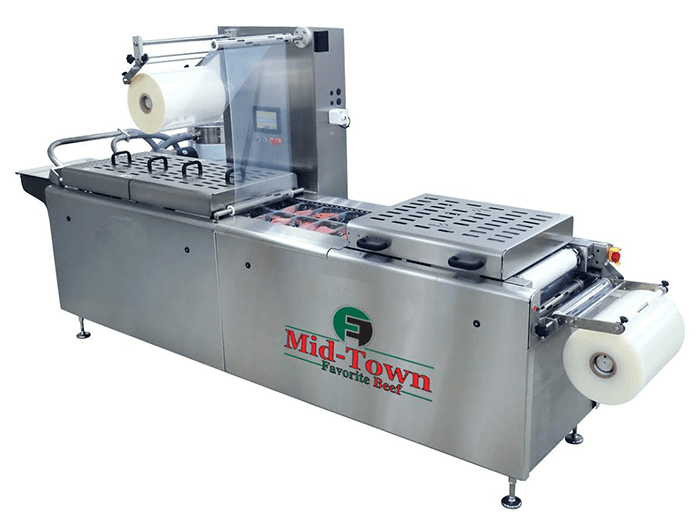
Packaging
What are the benefits of vacuum sealing our meats?
Traditionally, vacuum-sealed packaging has been used to keep cured meats like bacon and hot dogs fresh. Mid-Town Favorite Beef utilizes this type of packaging for the many benefits it brings to keeping meat fresh.
All of our meat packaging and refrigeration is designed to protect against exposure to oxygen and heat; which breeds the bacteria causing spoilage. Keeping meats chilled and wrapped in plastic only addresses half of the problem, as traditional plastic wraps allow oxygen to penetrate packaging. Implementing vacuum-sealed packaging essentially increases the meats shelf-life by removing most of the oxygen, inhibiting the growth of bacteria.
Vacuum-sealed packaging gives the end user the freedom to cook meats according to their own timetable. With the oxygen removed, the shelf-life of vacuum sealed red meat increases from a few days to at least two weeks. Because of this extended time period spoilage is significantly decreased, meaning less items thrown away. This also includes ground beef, which inherently needs to be used within a day or two of purchase, but now has a shelf-life nearly double the amount of time from the use of vacuum packaging.
Meat that has to be thrown out is a substantial loss of time, energy, and money. By increasing the products shelf-life, the urgency to freeze your meats right away to keep them from going bad is no longer a priority; however freezing is still an option if you’re looking to stock up. Vacuum-sealed packaging compliments the freezing process as the lack of oxygen on the surface of the meat prevents freezer burn and eliminates the necessity to have additional packaging and preparation for storage. Additionally vacuum-sealed meats not only keeps the oxygen out, but also keeps juices in minimizing the cross-contamination with other foods.
Visually, meats that have been vacuum-sealed will be noticeably different from those packaged in a conventional manner. Vacuum-sealed meats will have a darker hue as opposed to the bright red color that is representative with traditional packaging. What does this all mean? The red color represents the beginning of the meats spoiling process due to the exposure to oxygen. Meats with the darker complexion are protected due to the vacuum-sealing process. Once opened the meats will be exposed to oxygen and will redden to the usual color. This small cosmetic change in meat color is trivial when compared to the benefit in the products freshness and quality.